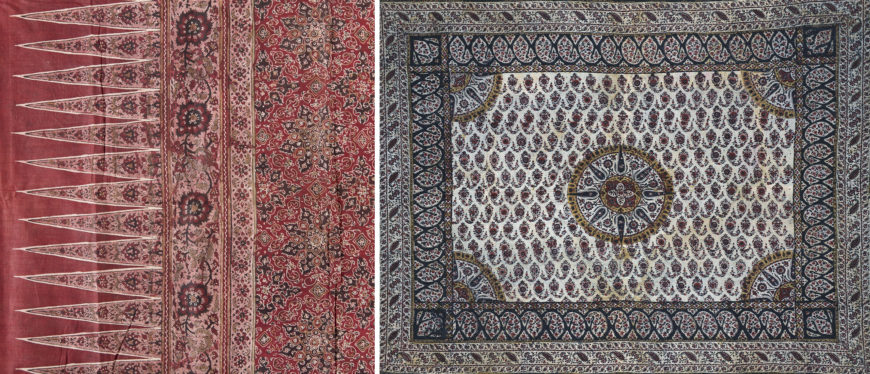
Left: chevron (detail), skirt cloth (Kain Sembagi) with chevron pattern, late 19th–early 20th century (Andhra Pradesh), cotton and natural dyes, 260 x 113 cm (Museum of Art and Photography, Bengaluru); right: paisley (detail), Kalamkari with paisley motifs, 20th century (Andhra Pradesh), cotton and natural dyes, 113 x 88 cm (Museum of Art and Photography, Bengaluru)
Motifs are decorative and storytelling devices that convey the cultural, historical, and artistic contexts within which textiles are crafted. These are often combined and repeated in groups to form elaborate patterns on fabrics, revealing the expert use of color and symmetry. Found across different artistic traditions of the Indian subcontinent in varying styles and templates, motifs on textiles can serve aesthetic and symbolic functions for both their makers and wearers.
Common motifs used in the Indian subcontinent are inspired by a range of influences from within the region as well as from other cultures, through trade and exchange. Some influences include:
- Flora and Fauna
- Religion and Mythology
- Art and Architecture
Let’s look at some of the most prominent motifs featured on South Asian textiles.
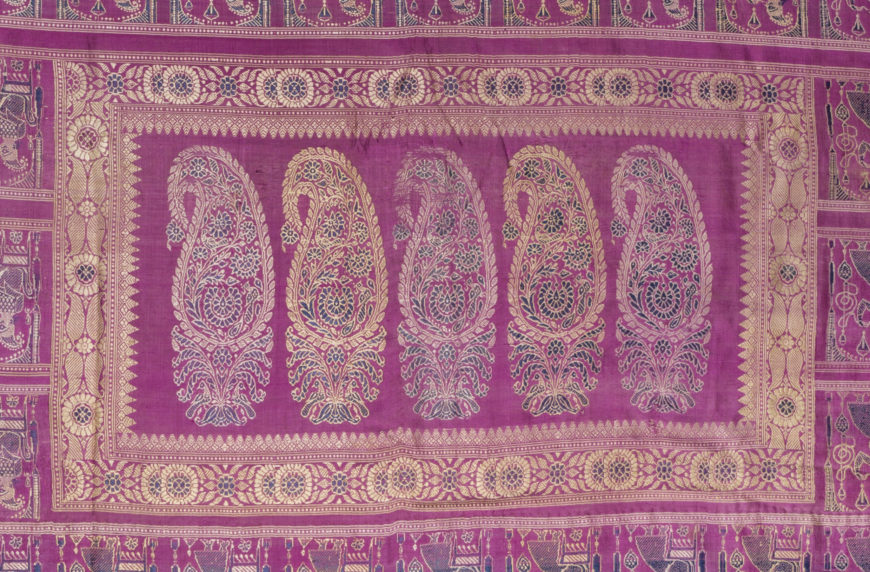
Paisley (detail), Baluchar Sari with paisley motifs, early 20th century (Undivided Bengal), silk, 420 x 109 cm (Museum of Art and Photography, Bengaluru)
Paisley
Known by different regional names such as Kairi in Gujarat and Rajasthan, Mangkolam in Tamil Nadu, and Kalka in Bengal, this motif is characterized by its elongated mango shape, which also resembles a teardrop. Found across most textile traditions in the subcontinent—from the silk brocade weaving centers of Kanchipuram in the South to the block printing centers in the West—it has diverse origin stories. While some weavers believe that the motif was introduced by the Persianate world, it is also likely that it developed independently in a number of regions. Along with the large-scale international trade of pashmina shawls from Kashmir, the motif too became widespread all over the world. By the 18th century, these shawls started to be mass-produced in the UK, most prominently in a small town in Scotland, known as Paisley, from which the most commonly used name for the motif derives. This motif continues to be widely used around the world in fashion and design.
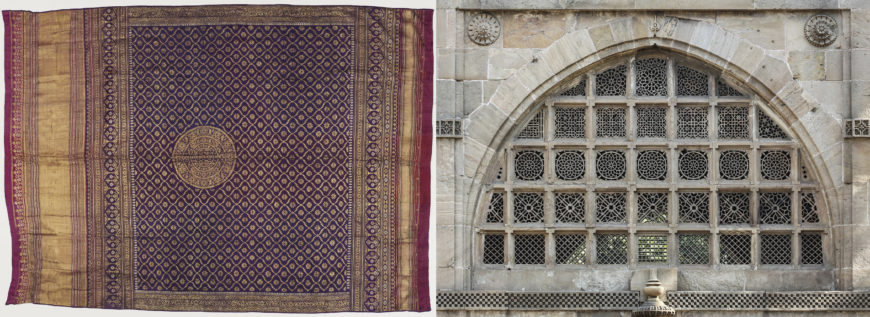
Left: brocade odhani with jaali pattern, late 19th–early 20th century (Gujarat), silk, gilt metal, and cotton, 234 x 166 cm (Museum of Art and Photography, Bengaluru); right: jaali latticework, Sidi Saiyyed Mosque, Ahmedabad, India (photo: Bernard Gagnon, CC BY-SA 3.0)
Jaali
Inspired by the intricate trellis or lattice pattern seen on Islamic and Indic architecture, jaali is a popular pattern depicted in a number of textile traditions such as Kalamkari, Banarasi brocade, Ajrakh, and Patola. The design is geometric, and can be made up of ornamental, stylized lines and shapes such as vines and florals. This motif is commonly seen in Mughal and Rajput miniature paintings and architecture, such as mosques and other buildings in north and north-western regions of the subcontinent.
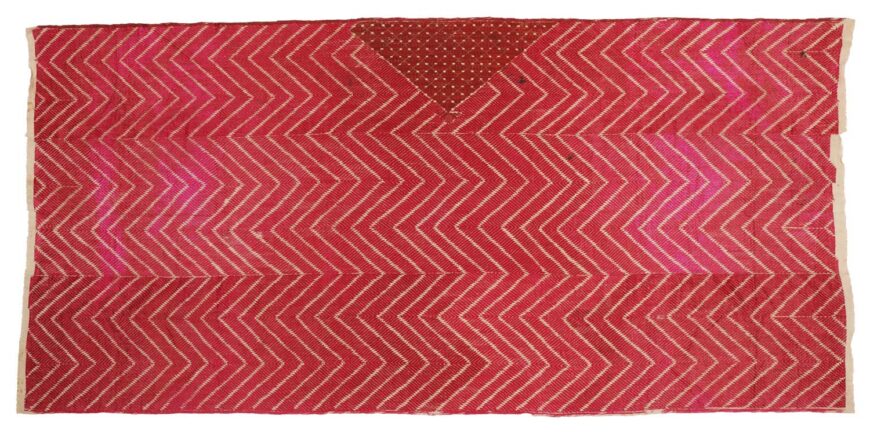
Thirma Bagh Phulkari with chevron pattern, late 19th–mid-20th century, cotton, floss silk, 116 x 248 cm (Museum of Art and Photography, Bengaluru)
Chevron
Seemingly simple zigzag patterns, chevrons are used as borders in many textiles. These patterns are often stylized, and are known by other names such as saw-tooth, or tumpal in Indonesia. They are also commonly recognized as ‘temple borders’ in certain textiles traditions, where artisans draw inspiration from the jagged edges seen on the silhouettes of temple spires in the towns they are from. Chevron borders are found in many sari traditions such as Kanjivaram brocades, Pochampally ikats and Patan Patola. They also feature on Phulkari shawls as the primary pattern.
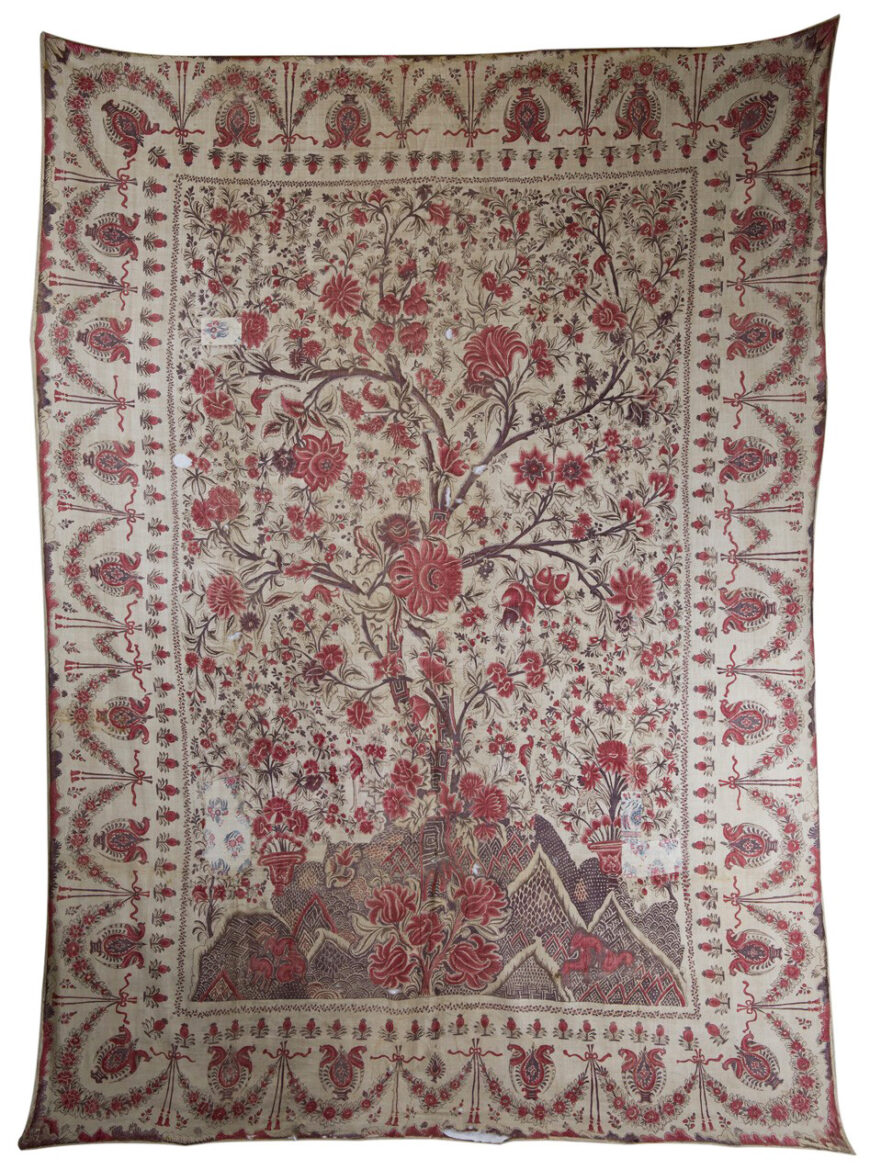
Kalamkari Palampore with Tree of Life motif, mid-18th–mid-19th century (Coromandel Coast, India, for European market), cotton, natural dyes, 295 x 212 cm (Museum of Art and Photography, Bengaluru)
Tree of Life
Popularized in large hand-painted Palampores—which were Kalamkari hangings made in the 17th and 18th centuries—the Tree of Life is a cosmological motif depicting a large tree emerging from the earth. Recognized and adapted by cultures all over the world, it symbolizes the connection between heaven and earth, and often features in several origin myths, Indian folk arts, and also in architecture.
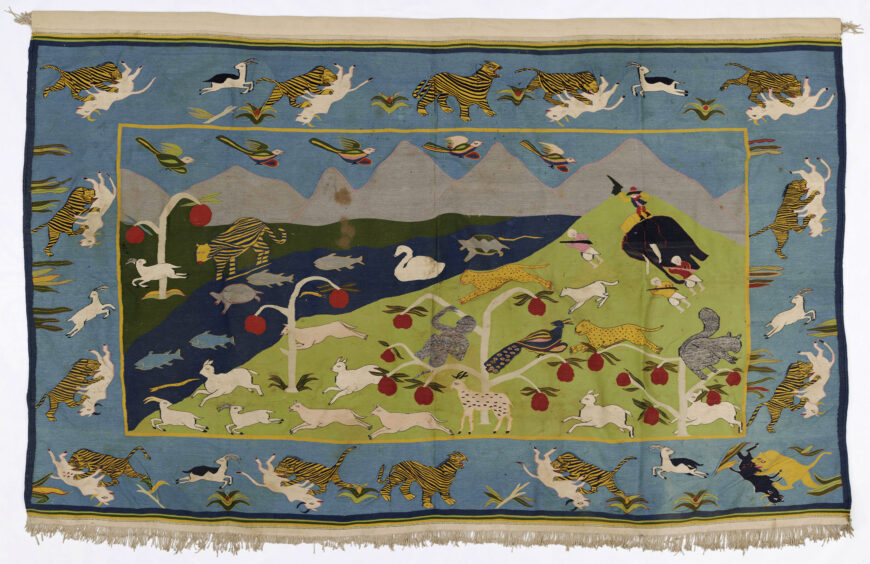
Shikargah Dhurrie, 1940 (North India), cotton, 254 x 159 cm (Museum of Art and Photography, Bengaluru)
Shikargah
Derived from the Persian word for hunting, Shikargah refers to depictions of hunting scenes, most commonly seen in carpets from Central and South Asia, Banarasi silk brocade saris and lehengas, and Kashmiri shawls. These scenes may feature kings or noblemen pursuing animals in forests or feature wild animals pursuing domestic beasts. Shikargah scenes are often characterized by overtones of beastly violence.
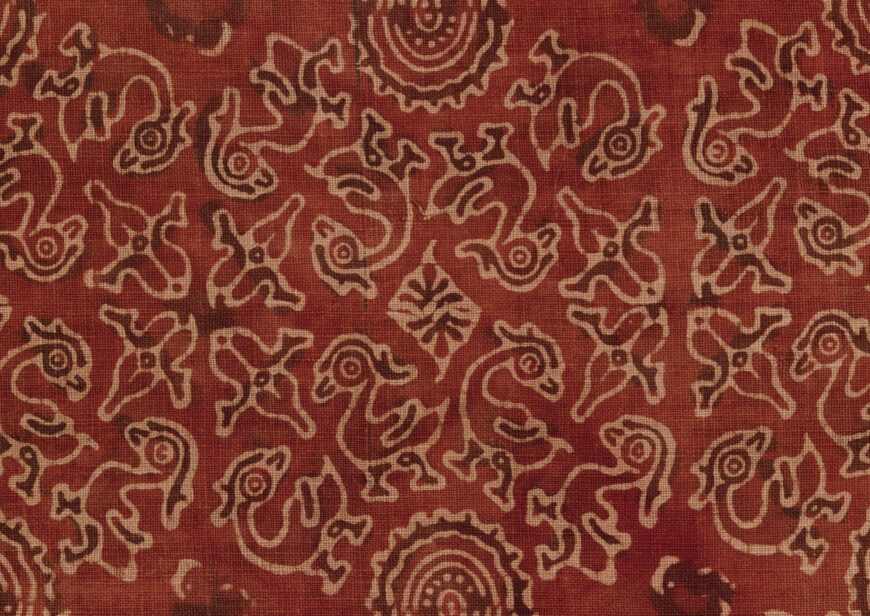
Hamsa design (detail), textile with sacred goose (hamsa) design, 15th–early 16th century (Gujarat, for Indonesian Market), cotton, 103.5 x 481.3 cm (The Metropolitan Museum of Art, New York)
Hamsa
Hamsa or the annapakshi is a mythical, swan-like bird often associated with the goddess Saraswati. A common symbol in Hindu and Buddhist traditions, it has been represented in different types of textiles across the country for centuries. Various iterations of the motif can also be found on other forms of art, ranging from sculptures to devotional objects and even paintings.
In addition to the more prominent motifs and designs across the subcontinent, we can also find specific motifs and designs within each textile tradition that are often derived from the local cultures. These usually help in forming the unique visual vocabulary of that particular textile practice. The use of simple motifs to form complex patterns on textiles demonstrates the creativity of the artisans. Often, it is the harmonious and even unexpected arrangement of a combination of motifs that sets a textile apart and makes it a treasured piece. We can think of motifs as a language of their own, directly connecting the textiles to art history, visual culture, and deeper symbolism.
Additional resources
Take a short course on Textiles from the Indian Subcontinent with The MAP Academy
John Gillow and Nicholas Barnard, Traditional Indian Textiles (New York: Thames and Hudson, 1991).
Sylvia Houghteling, “The Tree of Life and the World of Wonder: ‘Aja,ib Imagery on 17th-Century Kalamkaris,” Scent upon a Southern Breeze: Synaesthesia and the Arts of the Deccan, edited by Kavita Singh (Mumbai: Marg Foundation, 2018).
Ben Skarratt, Scarlett Mansfield, and Christopher McKenna, “From India to Europe: The Production of the Kashmir Shawl and the Spread of the Paisley Motif,” Global History of Capitalism Project, University of Oxford (August 2018).
Drawing from articles on The MAP Academy





